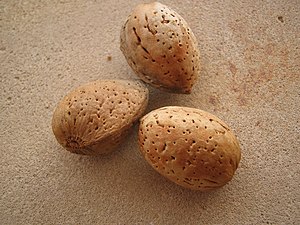Note: This is a project under development. The articles on this wiki are just being initiated and broadly incomplete. You can Help creating new pages.
Prunus dulcis - Almond
Prunus dulcis is a deciduous shrub or a small tree with erect branches when young, becoming horizontally-spreading as it grows older. It can grow 4 - 8 metres tall. The almond is one of the most commonly consumed nuts on Earth. It is often cultivated in warmer regions of the temperate zone, especially in the United States, which now dominates world almond production with over 40% of the annual crop, all of it grown in or near the Central Valley of California.
Contents
- 1 Uses
- 2 Parts Used
- 3 Chemical Composition
- 4 Common names
- 5 Properties
- 6 Habit
- 7 Identification
- 8 List of Ayurvedic medicine in which the herb is used
- 9 Where to get the saplings
- 10 Mode of Propagation
- 11 How to plant/cultivate
- 12 Commonly seen growing in areas
- 13 Photo Gallery
- 14 References
- 15 External Links
Uses
Kidney stones, Gallstones, Constipation, Cancer, Diabetes.
Parts Used
Chemical Composition
Common names
| Language | Common name |
|---|---|
| Kannada | |
| Hindi | |
| Malayalam | |
| Tamil | |
| Telugu | |
| Marathi | |
| Gujarathi | |
| Punjabi | |
| Kashmiri | |
| Sanskrit | |
| English |
Properties
Reference: Dravya - Substance, Rasa - Taste, Guna - Qualities, Veerya - Potency, Vipaka - Post-digesion effect, Karma - Pharmacological activity, Prabhava - Therepeutics.
Dravya
Rasa
Guna
Veerya
Vipaka
Karma
Prabhava
Habit
Identification
Leaf
| Kind | Shape | Feature |
|---|---|---|
| Simple | Alternate | Deciduous; petiole (8–)10–25 mm, ˂usually winged distally˃, glabrous, usually glandular distally or on margins at bases of blades. |
Flower
| Type | Size | Color and composition | Stamen | More information |
|---|---|---|---|---|
| Bisexual | Axillary | Pink-white | Solitary flowers or 2-flowered fascicles. Pedicels 1–5 mm, glabrous. Flowers blooming before leaf emergence; hypanthium cupulate, 4–7 mm, glabrous externally. |
Fruit
| Type | Size | Mass | Appearance | Seeds | More information |
|---|---|---|---|---|---|
| Drupes | 25–40 mm | Gray-green, ovoid-oblong, ˂compressed˃, 25–40 mm, velutinous; mesocarps leathery (splitting) | stones ellipsoid, strongly flattened, pitted |
Other features
List of Ayurvedic medicine in which the herb is used
Where to get the saplings
Mode of Propagation
Seeds, Softwood cuttings, Cuttings of mature wood.
How to plant/cultivate
The almond prefers a Mediterranean or a Continental climate, with a clear distinction between winter and spring, in milder maritime areas it can be induced into flower too early in the season and is then very liable to be damaged by frosts.[3]
Commonly seen growing in areas
Cultivated ground, Thickets, Hedges, Rocky places, Mountainous areas.
Photo Gallery
References
- ↑ [Chemistry]
- ↑ Morphology
- ↑ Cultivation
External Links
- Ayurvedic Herbs known to be helpful to treat Kidney stones
- Ayurvedic Herbs known to be helpful to treat Gallstones
- Ayurvedic Herbs known to be helpful to treat Constipation
- Ayurvedic Herbs known to be helpful to treat Cancer
- Ayurvedic Herbs known to be helpful to treat Diabetes
- Herbs with Seeds used in medicine
- Herbs with stem used in medicine
- Herbs with leaves used in medicine
- Herbs with Root used in medicine
- Habit - Deciduous tree
- Index of Plants which can be propagated by Seeds
- Index of Plants which can be propagated by Softwood cuttings
- Index of Plants which can be propagated by Cuttings of mature wood
- Herbs that are commonly seen in the region of Cultivated ground
- Herbs that are commonly seen in the region of Thickets
- Herbs that are commonly seen in the region of Hedges
- Herbs that are commonly seen in the region of Rocky places
- Herbs that are commonly seen in the region of Mountainous areas
- Herbs
- Rosaceae







